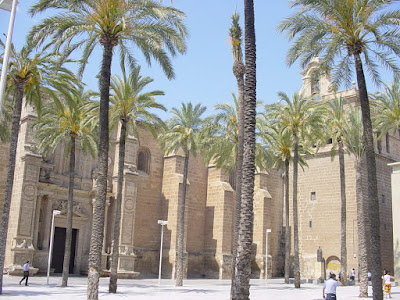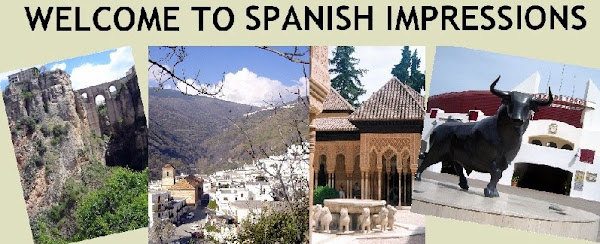.
I am not really of a religious persuasion but the 'churches of Almería' make for a pleasant walk.
 |
| San Pedro |
A good place to start is the Plaza San Pedro.
From the plaza, the Iglesia San Pedro presents an attractive façade comprising a portico flanked by twin towers.
From San Pedro, walk to the Paseo de Almería and thence to Puerto Purchena, the heart of the city centre. From there, the Plaza San Sebastian is only a few minutes away. The square is very attractive with the little garden containing palms and shrubs opposite the main entrance to the church of 'San Sebastian'.

There is also a delightful little statue on the garden's edge, a simple monument to the Immaculate Conception. It was originally erected in 1800 and restored after the 1936 Spanish Civil War.
From the 11th century onwards, the plaza was apparently one of the most populous parts of the city. In Moorish times, a mosque stood there and later, in Christian Almería, it became a shrine to Saint Sebastian. In the 17th Century, the church was built.
 |
| San Sebastian |
Return to Puerto de Purchena and enter the old shopping street of Calle de las Tiendas where St. James church is located. The main façade of this church is really rather splendid. Its imposing Renaissance portal is similar to the Cathedral's doorways and above the door are magnificent sculptures including one depicting St. James, Slayer of the Moors. This church is one of the oldest in the town. It was built in the times of Bishop Fray Diego Fernández de Villalán who occupies an important place in the annals of the Church in Almería because of his zeal as priest and founder of new buildings in the city. His shield is also to be found above the main door.
 |
| St. James (Santiago) |
 |
| Las Claras |
Continue to the end of Calle de las Tiendas to arrive in Calle Jovellanos. Immediately opposite, is the main door of the 'Iglesia Convento Las Claras'. Above the door, is highly intricate artwork that includes a niche housing a statue of St. Clara.
Take Calle Mariana and Calle Cervantes to arrive at the extremely attractive and spacious Plaza de Catedral. (see my separate blogs for details of the Cathedral of Almería).
 |
| Plaza de Catedral |

Walk in a westerly direction to enter the old 'Musalla Quarter, a maze of little streets. At every turn, the magnificent 'Alcazaba' can be spotted up on its arid hill. During the 11th century, Almería ceased to be part of the 'Caliphate of Cordoba' and became an independent kingdom. Many refugees from the Cordoban Civil War sought shelter in Almería but had to settle outside the old city walls. New defensive walls were built and the area between the older and the newly built walls was called the 'Musalla Quarter'.
In Calle Almedina, the church of 'St. John' was built on the ruins of the 'Great Mosque of Almedina' and, with great foresight, some of the Moorish characteristics were left intact. After the Catholic Kings' conquest of Almería in 1489, the mosque, which had been built in the 10th century, became the city's first cathedral. However, the earthquake of 1522 destroyed most of the building. This prompted the building of the present Cathedral-Fortress in 1524. Later, in the 17th century, Bishop de Portocarrero instigated work on the present church of 'San Juan'. During the Civil war it was bombed on several occasions. In 1979, it was rebuilt and then fully restored in 1991 when both the mosque's kibla and mihrab were restored and the church given a new roof. All this information I have obtained from tourist web sites. Whenever I have tried to visit,
the building has been closed. The exterior is unimpressive having been built of large rectangular slabs. In my opinion it is the most ugly looking church I have ever seen and probably not worth the detour. (The bar opposite, 'Café Bar San Juan', is OK though if by now you are feeling a tad thirsty. On my last visit I ordered a beer and a tapa of pescado del día and was given four small fishes. It may not have fed the five thousand but it was a good enough snack for me!)
 |
| Las Puras |
Walk back up Calle Almedina, cross Calle de Reina and back to the Plaza de la Catedral. I really do like this square with the tall palm trees and the golden coloured walls of the 'Cathedral' and the 'Episcopal Palace'. A few yards away is another religious building - the 'Convento de las Puras'. This 17th century church was formerly a convent. There is not a lot to see as the church is usually closed and the main façade is a bit on the plain side though nowhere near as bad as the church of St. John. However, there is an attractive sculpture above the door consisting of a coat of arms flanked by two lions' heads. I have seen the inside of this church when I attended a classical concert held there a few years ago. I remember being impressed by the building's baroque interior. Next to the 'Convento de las Puras', is a modern apartment block - all glass and aluminium. If this building had been next to one of the more attractive churches, I would have shouted "Sacrilege". I still think the building should not have been allowed, as it is not in keeping with the architectural style of this part of Almería.
Return to the Plaza de la Catedral and make your way in a south easterly direction to the 'Iglesia Virgen del Mar'. Whenever I walk through this historic quarter of the city, I admire the colourful houses with their intricate wrought-iron window grilles, the old-fashioned lampposts and the mimosa trees. These trees provide welcome relief from the fierce Almerian sun, especially in Calle Trajano where one can sit in the shade with a drink outside one of the little cafes.
 |
| Plaza de la Virgen del Mar |
The Virgen del Mar church is a good deal more attractive than the previous two although it too is often closed. It is situated in the Plaza Virgen del Mar, which is another quiet spot in the heart of the old town. Park benches and attractive trees line the little park on the side of the square. These trees, ficus retusa, are to be found in many streets in Almería, Roquetas and many other towns and villages that I have visited in the province. They usually look smart as the town councils ensure that they are regularly trimmed into a neat cylindrical shape. Another feature I like in Almería is the wrought-ironwork, not only the intricately decorated window grilles on the façades of the buildings but the lampposts which remind me of the old-fashioned lampposts I have seen in pictures of Victorian London.
 |
| Virgen del Mar |
A couple of streets away, there was another church, - 'Iglesia del Sagrado Corazón de Jesús'. It was closed and what's more, it was so uninteresting to look at that it is not worth talking about - so I won't! Just around the corner, was the much more attractive San Pedro church where I started my walk.
Other religious buildings in Almería:
 |
San Roque
(near the port)
|
 |
Ermita de San Anton
(near the Alcazaba) |
Robert Bovington
author of "Spanish Matters" & "Spanish Impressions"
|





























